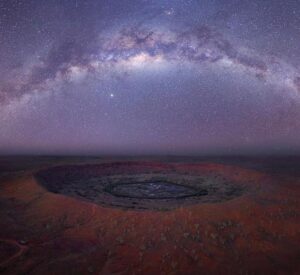 Pin
Pin Every day the Sun pours down on to the Earth enough energy to power every house, factory, car, ship and plane in the world for about 30 years. A tiny amount of this energy is used to evaporate the oceans to make clouds, to drive the winds, or by plants in photosynthesis. But all the rest is radiated back into Space, either by reflection from the clouds, or from the cooling Earth’s surface during the night.
In these energy-short days the search is on to find ways to collect and make use of least some of this energy, rather than let it all radiate away and be lost.
There are many possible ways of collecting and using this ‘solar energy’ or energy from the Sun. The greenhouse, pride and joy of most keen gardeners, is one everyday example, and another, which has been in use since the earliest times, is the production of salt by allowing the Sun to evaporate sea water in shallow lagoons or ponds. Other simple ways are shown in this post, stay focused and read.
 Pin
Pin  Pin
Pin 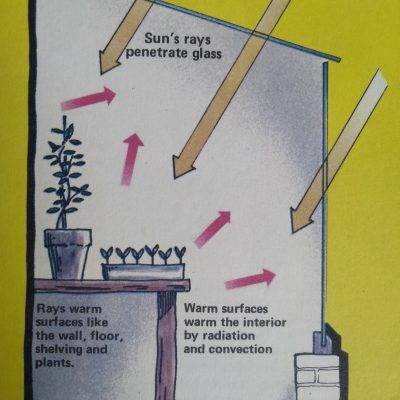 Pin
Pin One of the simplest ways of trapping the Sun’s energy is the greenhouse. Although light will pass through glass, infrared radiation will not (see above picture). So when the light heats up surfaces such as the floor or benches, the energy they radiate (infra-red) cannot escape.
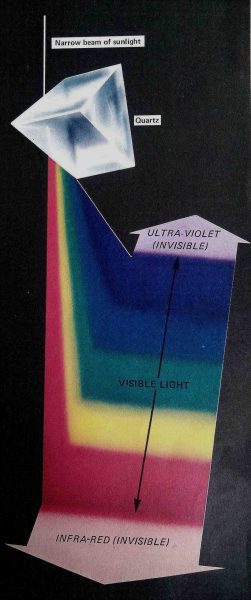 Pin
Pin The Sun’s rays contain many different wavelengths of energy, from ultra-violet (short), through visible light, to infra-red (long). If the rays are passed through a triangular piece of quartz, they are split into parts — the visible light appearing as the colours of the rainbow.
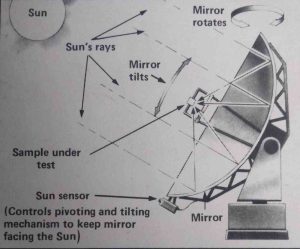 Pin
Pin Like a giant magnifying glass, a solar furnace collects the Sun’s rays into one spot. At this focal point temperatures can reach many hundreds of degrees Centigrade. Unlike normal furnaces, such high temperatures can be achieved quickly (by turning the furnace towards the Sun) and just as quickly lost (by turning the furnace away from the Sun). Solar furnaces are therefore particularly useful in testing the effects or rapid temperature changes in metal alloys used in engines and aircraft.
The idea is simple. Sunlight is energy; electricity is energy. All you need do is convert one form of energy to the other. If just a tiny amount of the Sun’s enormous energy was turned into clean, easy-to-use electricity, the world’s energy problems would be over.
The idea is simple enough, but putting it into practice is anything but — at least not in the huge way necessary if it is to make a significant contribution to the world’s energy needs.
It is fairly easy to convert sunlight into a small amount of electricity — one kind of photographic exposure meter, for example, does just that. The sunlight falls on a piece of silicon (silicon has the property of letting electricity pass through it in one direction only) and turns it into a tiny battery — a solar cell. Basically, the energy from the Sun drives the tiny electrical particles, called electrons, from their normal places in the atoms of the silicon. The flow of electrons is electricity. The more sunshine there is, the more electricity is produced.
The method works well for the tiny amount of electricity needed in an exposure meter, but there are problems in producing large amounts. Firstly, the method is very inefficient. Secondly, the silicon has to be very pure if it is to produce a reasonable amount of electricity. Very pure silicon is expensive, and because the total energy from the Sun in parts of the world that need electricity is only about 100 watts per square metre, solar cells have to cover a very large area to produce useful quantities of electricity. Large areas mean a lot of silicon and therefore enormous expense.
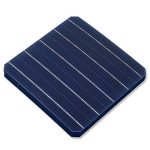 Pin
Pin 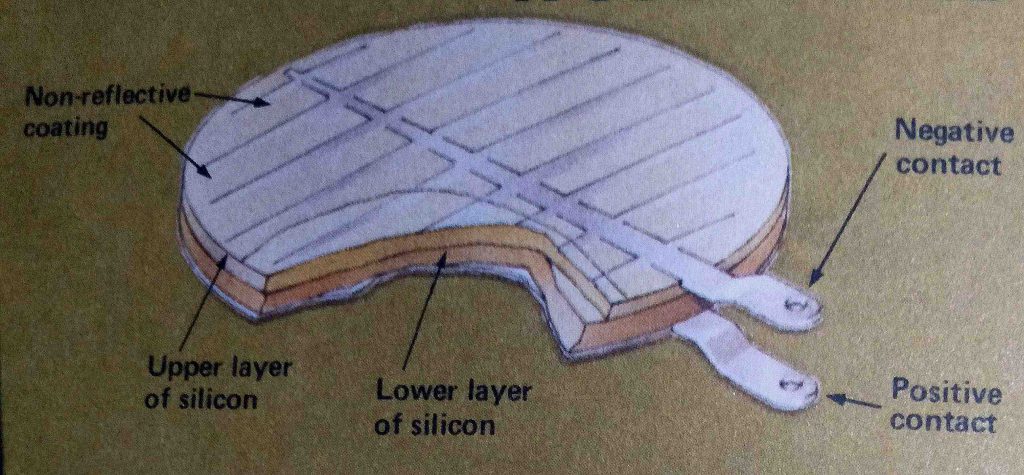 Pin
Pin At the moment, the solar cell is the only practical method of getting electricity directly from sunlight. Each cell is essentially a very large silicon crystal with a minute amount of boron mixed into its upper half, and arsenic in its lower half. Electricity is generated where the two halves meet. it is collected by a thin metal ‘contact’ on the top surface, while another contact, which can cover the whole of the back surface, completes the circuit back to the cell. The very top of the cell is coated with a non-reflective material so that as much sunlight as possible is absorbed and not reflected uselessly away. The photograph (above left) shows a commercial solar cell.
What is Solar Power : Video
Expensive
In fact, at present, solar cells are too expensive to be used except when the cost does not matter very much. The most obvious example of this is in space research. A satellite needs energy, and there is, of course, plenty of solar energy in Space. This is why Skylab, the space laboratory, was fitted with an array of solar cells — partly in the form of what looked like windmill blades on the top of the satellite. Nevertheless, although the windmill blades of Skylab are much more advanced than a simple exposure meter, the basic principle is the same.
But a cheaper, more down-to-earth method is needed where cost matters.
One approach is to use a different material. Pure silicon cells are very expensive partly because they must be made of an enormous number of very pure single crystals of silicon linked by delicate electrical connections. But some scientists have found that some other substances which are not crystals can be made to behave like silicon. There is hope that these substances could be made very cheaply. They could be the basis of a practical form of solar cell.
 Pin
Pin 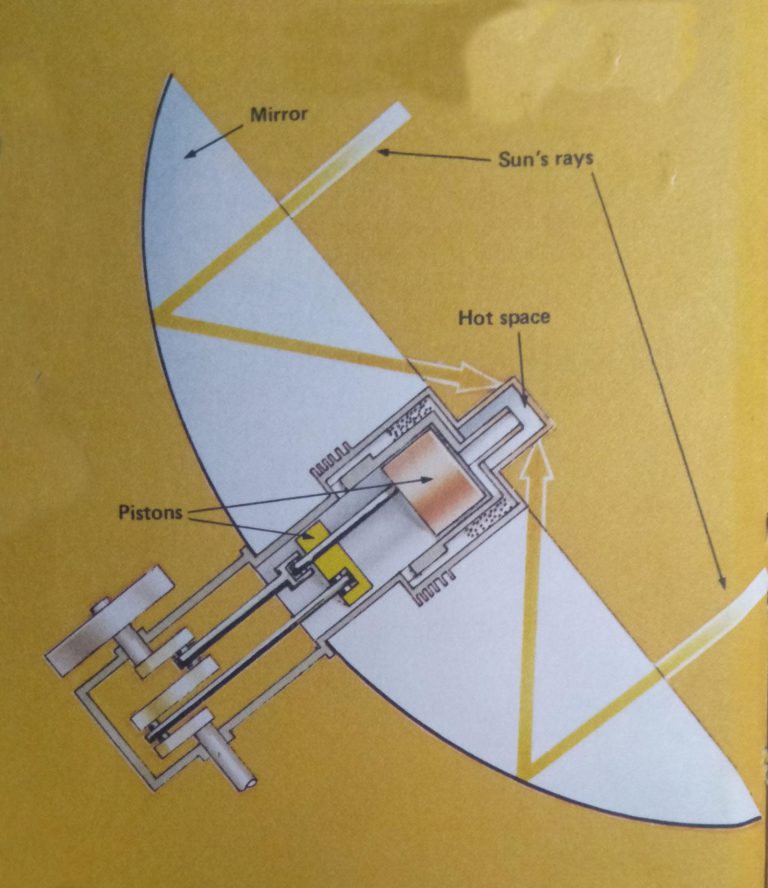 Pin
Pin Above Left: One way of getting more light into an array of solar cell is to use a mirror. However, solar cells only work efficiently at temperatures up to 50°C, so some method of cooling them becomes necessary. One way of doing this is to pass water through transparent panels around the cells. So usable hot water is obtained as well as electricity.
Above Right: The heat engine (invented by Robert Stirling in 1816) can be driven by the Sun. The Sun’s rays, collected by the mirror, warm air inside the ‘hot space’ of the engine. The hot air expands and drives the engine.
 Pin
Pin One of the most promising ways of using the Sun to make electricity is the solar pond, working examples of which have been built in Israel. The water at the bottom of the pond is more salty than that at the top. The Sun’s rays striking the floor of the pond heat up the bottom waters. In a normal pond this hot water would rise and mix with the cooler top water, but because salt water is heavier than fresh water, it does not rise in the solar pond and becomes increasingly hot. This hot water is pumped off and passed first through a desalination plant (which removes salt) and then through a heat pump. A heat pump works like a refrigerator in reverse and can be used to transfer the heat into a large amount of water to a smaller amount of water — which can become very hot indeed. in this way hot water from the pond is used to make steam to drive a turbine to make electricity. Very salty water from the desalination plant is pumped to the bottom of the pond, fresh water is returned to the top of the pond. So the top remains less salty than the bottom.
Solar Energy
Solar energy refers to harnessing the power of the sun to generate electricity or heat. It is a renewable and sustainable source of energy that can be used in a multitude of applications such as residential, commercial, and industrial sectors.
The history of solar energy dates back thousands of years, with its earliest usage believed to be in the 7th century BC by ancient Greeks and Romans. They designed buildings with large windows and used mirrors to reflect sunlight into indoor spaces, serving both as a source of light and heat. In ancient China, solar water heaters called “solar furnaces” were used to warm homes and bathwater.
However, the modern history of solar energy began in the 19th century, with the discovery of the photovoltaic effect. In 1839, French physicist Alexandre Edmond Becquerel discovered that certain materials produced a small electric current when exposed to light. This laid the foundation for the development of solar cells.
In 1954, Bell Laboratories in the United States created the first practical silicon-based solar cell. It had an efficiency of around 6%, making it the most efficient solar cell at that time. This breakthrough led to the commercialization of solar panels and the beginning of the solar energy industry.
During the space race of the 1960s, solar energy gained further momentum as NASA sought to power their space exploration missions using solar panels. The first successful use of solar-powered spacecraft was the Vanguard 1 satellite, launched in 1958. This marked a significant milestone in the application of solar energy beyond Earth.
The oil crisis of the 1970s further accelerated the interest in solar energy. As oil prices skyrocketed and energy security became a concern, countries started investing in solar research and development. Government subsidies were introduced to encourage the installation of solar panels, and solar energy systems became more widely available for residential and commercial use.
Since then, solar energy technology has continued to evolve and improve. The efficiency of solar cells has increased, allowing for greater energy conversion from sunlight. The production costs of solar panels have also significantly decreased, making them more affordable and accessible to the general population.
Today, solar energy is a mainstream source of electricity generation in many parts of the world. It provides a clean and renewable alternative to traditional fossil fuel-based energy sources, reducing greenhouse gas emissions and combating climate change. Solar farms and rooftop solar panels can be seen in many countries, contributing to the global energy transition towards cleaner and sustainable alternatives.
In conclusion, solar energy has a rich history that spans centuries. From the ancient Greeks and Romans to modern-day advancements, solar energy has come a long way in harnessing the power of the sun. Its increasing popularity, coupled with technological advancements, holds great promise for a brighter and more sustainable future.
Valuable fuel
Another possibility was being developed in Israel. Put very simply, the energy of the Sun is harnessed to split water into the two elements it is made of, hydrogen and oxygen. The hydrogen is a very valuable fuel — it can be used to drive motor cars or machinery.
Once again the idea behind the invention is simple. The sun shines on a solar cell that is standing in water. The water has previously been treated with a chemical so that it conducts electricity, and the solar cell is connected by a wire to a piece of metal that also stands in the water. Because the sunlight turns the cell into a tiny battery, an electric current flows along the wire, and this current splits the water into hydrogen and oxygen.
Whether the idea proves to be practical commercially waits to be seen.
As well as their cost, another serious problem with solar cells is that they only produce energy when the sun is shining. However, a dramatic way of obtaining solar energy continuously is the ‘solar space island’. This is a very exciting and imaginative idea that sounds at first like science fiction.
In reality, however, the idea is so sound that the United States government has invested a lot of money in developing it. Put simply, the idea is to place solar cells on an artificial satellite. The satellite would be put into an orbit 35,652 km above the Earth. At this distance, it would go round the Earth once a day, which means that provided it was travelling in the same direction as the Earth spins, it would seem to stand still, hovering above one place, Because it would be so high up, it would be almost constantly in sunshine. And at that height, there are no clouds or fogs, no weather at all in fact, to shut off the sunlight.
The electricity generated by the solar panels would be converted into microwaves — the sort of radiation used in microwave ovens. The microwaves would be beamed to earth, where they would be picked up by aerials. They would then be reconverted into electricity, and added to the mains supply.
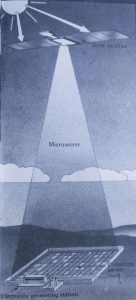
Exciting prospect
The planned satellite would be very large, about 24 km by 5 km. What is particularly exciting is that there is no need to construct this vast satellite on the ground and then try to build a rocket to take it into orbit. It can be built out in Space — astronauts already have the skills to do this. We still need an economical method of getting the materials up there, but this is not an insurmountable problem.
The Space Shuttle is being designed to take people up into Space cheaply, and a fairly crude ‘Space Tug’ could carry up the basic materials.
Building in Space has another advantage. At that altitude, the materials are nearly weightless. So the structure can be very flimsy and graceful — one that would not stand up on the Earth, where it would collapse under its own weight.
 Pin
Pin The solar car, running on sunlight, has been a dream for years, although a commercial design has never been found. Solar cells on the car’s roof recharge the car’s batteries, which drive electric motors to power the car. A separate battery runs the car’s lights.
 Pin
Pin SOLAR COOKER
Here’s one way of cooking the dinner!
Like a solar furnace, only much smaller, the curved mirror of the cooker reflects the Sun’s rays into one spot. In hot countries, like India for example, enough heat is captured to boil water quite easily. The cook, however, must sit nearby and keep turning the mirror towards the Sun to keep the food cooking. She must also turn the mirror away from the Sun when she removes the pot to avoid being burnt. .
 Pin
Pin SOLAR HOT-WATER SYSTEM
This sort of system is very often used in tropical and Mediterranean countries to provide hot water. A tank is placed on the roof of a house and connected to two or more glass box-like panels by pipes. Water in the panels is heated in the same way as inside a greenhouse. Because hot water is lighter than cold water, the hot water rises and flows into the tank, where it can be drawn off to be used in the house. The water used up in this way is replaced by cold water which enters the tank through a ball-valve — the sort of valve used in a lavatory cistern.
More complicated systems than this use pumps to move the water round, and have automatic controls, to stop the water getting too hot, or to turn the system off altogether in cold weather. In systems used in temperate countries, such as Britain, the hot water is not used directly because it rarely becomes hot enough. Instead it is pumped through a series of pipes (a heat exchanger) Inside the normal hot-water tank. This warms the water in the tank which is then fully heated by gas or electricity.
Solar energy has faced several challenges and obstacles in its development. Some of the major ones are as follows:
- 1. Cost: Historically, the cost of solar energy, particularly the cost of installing solar panels, has been a significant barrier. The high upfront cost of solar panels and associated equipment has deterred many potential adopters. However, in recent years, there have been significant improvements in manufacturing processes and economies of scale, resulting in a substantial decrease in the cost of solar panels. Technological advancements have also increased the efficiency of solar cells, making them more affordable and accessible.
- 2. Intermittency: Solar energy is reliant on sunlight, which is not available 24/7. The intermittent nature of solar power generation has created challenges in maintaining a consistent supply of electricity. To address this, there has been a significant focus on energy storage solutions such as batteries, which can store excess electricity generated during sunny periods and provide power during the night or cloudy days. The development of efficient and cost-effective energy storage technologies has helped mitigate the intermittency issue.
- 3. Grid Integration: Integrating solar energy into existing electricity grids has posed challenges due to the variability and decentralization of solar power generation. Solar energy often needs to be integrated with other energy sources to ensure a stable power supply. To address this challenge, grid operators have been investing in smart grid technologies, grid-scale energy storage systems, and advanced grid management techniques. These developments have improved the grid’s ability to handle variable renewable energy inputs.
- 4. Land Use: Solar farms require a significant amount of land to install the necessary infrastructure. The availability of suitable land and potential conflicts with other land uses, such as agriculture or conservation, have been a challenge. To address this, there has been a shift towards utilizing non-traditional spaces for solar installations, such as rooftops, parking lots, and brownfields. Moreover, developments in solar panel design, such as transparent solar panels and building-integrated photovoltaics (BIPV), have enabled solar energy generation without extensive land use.
- 5. Policy and Regulation: Inconsistent policy frameworks and lack of government support have hindered solar energy’s development. However, in recent years, many governments have adopted favorable policies to promote renewable energy, including solar power. These policies include feed-in tariffs, tax incentives, renewable portfolio standards, and net metering. Additionally, supportive regulatory frameworks have encouraged investment in solar energy and facilitated its integration into the electricity market.
Overall, advancements in technology, declining costs, improved grid integration, innovative deployment strategies, and supportive policies have addressed many of the major challenges faced by solar energy. These efforts have helped accelerate the development and deployment of solar energy globally.
Frequently Asked Questions for : Solar Energy
Solar energy is a renewable energy source that is derived from the sun’s radiation. It involves harnessing the sun’s light and converting it into electricity or heat for various applications. Solar energy can be utilized through photovoltaic (PV) systems, which convert sunlight directly into electricity, or through solar thermal systems, where the sun’s heat is used to generate power or heat water.
- Solar energy works by converting sunlight into usable energy. In the case of PV systems, solar panels made up of photovoltaic cells are installed on rooftops or other suitable locations. These cells are made from semiconductor materials that absorb photons from sunlight, which generates an electrical current. This flow of electrons can be harnessed and used as electricity to power homes and businesses.
- For solar thermal systems, flat-plate collectors or evacuated tubes are used to capture the sun’s heat. This heat is then used to heat water for domestic use or to generate steam for electricity production.
There are numerous benefits to using solar energy. Firstly, it is a clean and renewable source of energy, which means it does not produce harmful greenhouse gas emissions or contribute to climate change. Solar energy also reduces dependence on fossil fuels, leading to energy independence and enhanced energy security. Additionally, solar power can help lower electricity bills for homeowners and businesses, as well as create job opportunities in the solar installation and manufacturing industries.
The cost-effectiveness of solar energy depends on various factors, including the location, availability of sunlight, government incentives, and the size of the solar installation. While the initial installation costs of solar panels can be higher, there are long-term savings due to reduced electricity bills. Over time, the cost of solar equipment has decreased, making it more affordable for consumers. Additionally, government programs and incentives, such as tax credits and rebates, can further offset the upfront costs of installing solar panels.
Solar energy is most effective when there is direct sunlight, but it can still generate electricity during cloudy days. Solar panels can still absorb diffuse sunlight, although the energy output may be reduced. During nights or when sunlight is not available, PV systems can be connected to the grid, allowing homeowners to draw electricity from the utility company. Some solar installations also use battery storage systems to store excess energy produced during the day for use at night.
Solar panels typically have a lifespan of 25 to 30 years, but they can continue to produce electricity even beyond that period. The durability and performance of solar panels can be influenced by factors such as weather conditions, maintenance, and the quality of installation. It is important to choose reputable manufacturers and installers to ensure the longevity and efficiency of solar panels.
Net metering is a billing arrangement that allows homeowners or businesses with solar systems to receive credit for excess electricity generated. When solar panels produce more electricity than is needed, this excess energy is sent back to the grid. In return, the utility company provides credits or reduces the electricity bill for the surplus energy exported. Net metering enables consumers to offset their energy consumption and reduce their overall electricity costs.
Many governments offer incentives to promote the adoption of solar energy. These incentives can come in the form of tax credits, rebates, grants, or feed-in tariffs. The availability and extent of these incentives vary from country to country and even within different states or regions. It is recommended to consult with local authorities or solar installation companies to determine the specific incentives that may be applicable in your area.
While it is technically possible to install solar panels yourself, it is advisable to hire a professional solar installation company. Solar installations involve complex electrical work and structural considerations, necessitating trained personnel to ensure safety and optimal performance. Professional installers have the necessary expertise, experience, and knowledge of local regulations to install solar panels correctly and effectively.
Yes, solar energy systems can be integrated with existing electrical systems. PV systems can be connected to the electrical grid, allowing excess electricity to be exported and drawn from the grid when needed. Integration with existing systems often requires the installation of an inverter, which converts the direct current (DC) generated by solar panels into alternating current (AC) compatible with the grid.

















